Jaishree Nenwani's Blog
September 30, 2025
Book Review: Human Edge in the AI Age by Nitin Seth – Why Humanity Still Matters in the Age of Machines
Technology is evolving faster than ever, and artificial intelligence is at the center of this transformation. Every day, we hear debates about AI replacing jobs, reshaping industries, and even challenging our sense of identity. When I picked up Human Edge in the AI Age: Eight Timeless Mantras for Success by Nitin Seth, I was curious to see how a seasoned leader and bestselling author would approach this question: What will still belong to humans when machines can do everything else?
Reading this book felt like having a deeply personal conversation about the future — not just of work, but of life itself.
Why This Book Stands Out?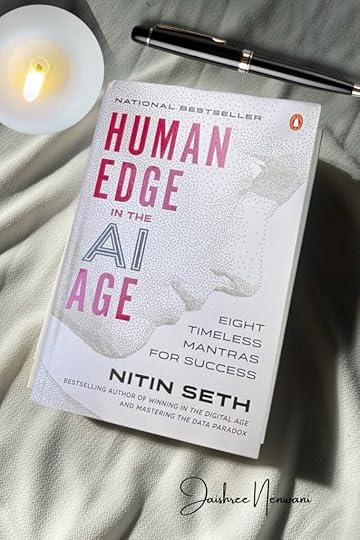
What struck me first is the balance between technology insights and human wisdom. Many books on AI lean too heavily into either fear or fascination with machines. This one doesn’t. Instead, Nitin Seth blends real experiences — from sitting in a self-driving car to reflecting on ancient wisdom from the Yoga Sutras and Bhagavad Gita.
This mix makes the book not just informative, but also soulful. It goes beyond facts and trends to ask bigger questions about empathy, creativity, and purpose — qualities that no algorithm can replace.
The POSSIBLE Framework – A Roadmap for HumansThe heart of the book lies in the POSSIBLE framework, which is built around eight timeless mantras: Problem-Solving, Openness, Spirituality, Sports, Impact, Balance, Leadership, and Entrepreneurship. Each one is explained with relatable stories, practical examples, and steps you can actually apply in your life.
For me, this was the real “human edge” the book talks about. It’s not just theory, it’s a toolkit. Whether you’re a professional navigating career changes, a student preparing for the future, or someone looking for personal growth, these eight dimensions act like a compass to stay grounded in the AI era.
Stories That Inspire Resilience and TeamworkOne of my favorite parts of the book is how Seth uses sports stories as metaphors for life. From India’s 2024 T20 World Cup victory to inspiring underdog tales from global football, he shows how resilience, teamwork, and adaptability are timeless human values.
These stories made me pause and reflect. They remind us that while machines can calculate probabilities and predict outcomes, the spirit of bouncing back under pressure — and doing it together — is something uniquely human.
Practical and Hopeful – Not Just Another AI Book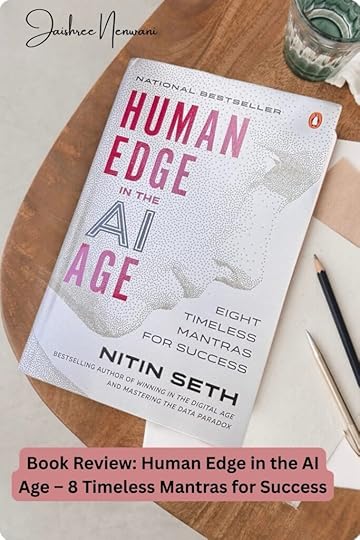
What makes this book refreshing is its tone of optimism. Instead of fueling fear about machines taking over, Seth offers a clear and hopeful path forward. Each chapter ends with actionable takeaways — small but powerful steps to sharpen skills like critical thinking, adaptability, and emotional awareness.
This practical angle makes the book not just a thought piece but also a personal guide. It helps you reframe AI not as competition, but as an opportunity to rediscover and strengthen your human core.
My Thoughts About Human Edge in the AI AgeI came away from Human Edge in the AI Age feeling inspired and reassured. It reminded me that in a world run by algorithms, the qualities that matter most are still deeply human: empathy, creativity, resilience, and courage. If you’re looking for a book that explains the future of AI while keeping humanity at the center, this one is a must-read.
About the AuthorNitin Seth is a respected global business leader, entrepreneur, and writer. He is the Co-Founder and CEO of Incedo Inc., where he helps businesses grow using digital tools, data, and AI. Over his 30-year career, he has held leadership roles at McKinsey, Fidelity International, and Flipkart, driving large-scale transformations at the intersection of technology and strategy.
He is also the bestselling author of Winning in the Digital Age (2021), which won the C.K. Prahalad Best Business Book Award, and Mastering the Data Paradox (2024), which quickly became a bestseller. Human Edge in the AI Age is his third and most personal book, written to inspire the next generation to thrive in a world shaped by AI. Nitin studied at IIT Delhi and IIM Lucknow, and today lives in New Jersey with his wife, three children, and their family dog.
Wanna discover more interesting books? Head towards the Book Review section.
This review is powered by Blogchatter Book Review Program.
The post Book Review: Human Edge in the AI Age by Nitin Seth – Why Humanity Still Matters in the Age of Machines appeared first on Jaishree Nenwani.
September 28, 2025
7 Habits of the People Who Stay Calm (Even When Life Gets Messy)
Ever wonder why some people stay cool as a cucumber while others lose their temper at the smallest hiccup? It’s not luck, and it’s definitely not that their life is free of problems. The truth is, calm people have trained themselves—through intentional daily habits to stay calm under stress—to handle challenges without spiraling into anxiety.
In today’s always-running, ever-connected world, staying calm can feel impossible. Work deadlines, overflowing inboxes, unexpected emergencies, and even small inconveniences can push us into fight-or-flight mode. But here’s the good news: calmness is not a personality trait you either have or don’t—it’s a skill you can develop.
I’ve spent years observing and practicing the habits of calm people during chaos. These habits are not complicated, but they’re powerful. They don’t just help in stressful moments—they prevent unnecessary stress in the first place.
Here are 7 simple but life-changing habits that keep me (and many others) calm, even when life gets messy.
1. They Arrive 10 Minutes Earlier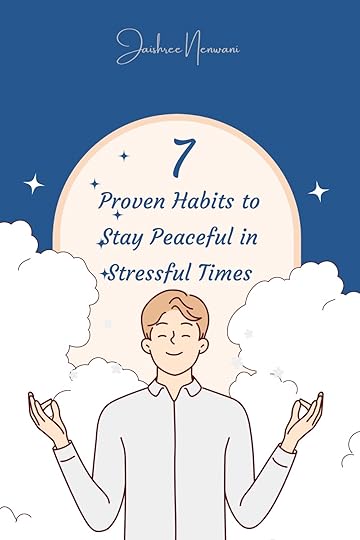
If you’ve ever raced against the clock, you know the feeling—your heart pounding, your shoulders tense, and stress building before you even start.
Calm people avoid this entirely by giving themselves a time buffer. I now aim to arrive 10 minutes earlier for everything—appointments, lunch dates, even virtual meetings.
Those extra minutes aren’t just about punctuality—they’re about presence. They give me time to settle in, breathe, and mentally prepare. People notice when you show up composed instead of flustered.
2. They Have a Shutdown RitualWork has a sneaky way of following us into the evening—unfinished tasks, half-read emails, and mental to-do lists.
To avoid this, I created a 10-minute shutdown ritual:
Clear my desk.Close all open browser tabs.Write my top 3 priorities for tomorrow.This signals to my brain: The workday is over. It’s like putting a period at the end of a sentence—you can relax without lingering stress.
3. They Practice Single-TaskingMultitasking is glorified, but it often leaves us scattered and stressed.
Calm people know the power of doing one thing at a time. If I’m writing, I’m not checking messages. If I’m on a call, I’m not answering emails. If I’m having dinner, I’m not scrolling through my phone.
Single-tasking doesn’t just lower stress—it makes each activity richer and more fulfilling.
4. They Make One Decision That Saves 1,000 Others
Every “yes” is a “no” to something else—often your own peace of mind.
Overcommitment is a silent stress killer. When my schedule is full, I make one decisive no. That single choice removes dozens of micro-decisions later.
This habit is a key part of how to stay calm when life gets messy—it keeps my plate from overflowing.
5. They Protect Their Mornings for Deep WorkYour morning energy is like a fully charged battery—don’t waste it on low-value tasks.
I reserve the first 90 minutes for deep, focused work:
No emails.No phone calls.No social media.By the time the day gets noisy, I’ve already accomplished something meaningful.
6. They Schedule Rest Like a Meeting“Rest isn’t a luxury—it’s maintenance.”
I treat rest like a meeting on my calendar: short breaks during the day, plus at least one mini-vacation or long weekend every quarter. And when I’m off, I’m off.
This simple habit of reducing stress every day helps prevent burnout before it starts.
7. They Respond Instead of ReactThe calmest people rarely react impulsively.
When something unexpected happens, they pause—sometimes just for a few seconds—before responding. This short pause allows for intentional, rather than emotional, action.
And here’s the secret: the other six habits make this one possible.
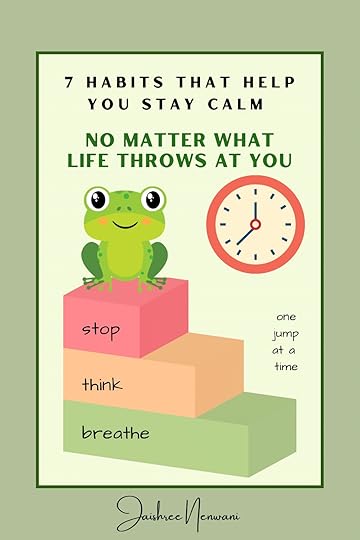 Wrapping Up on 7 Habits of the People Who Stay Calm
Wrapping Up on 7 Habits of the People Who Stay CalmCalmness isn’t about a perfect, problem-free life. It’s about building habits that create space for you to handle imperfect moments with grace.
You don’t need to master all seven at once. Start with one—maybe arriving earlier or single-tasking—and watch how it transforms your week.
Calm people aren’t calm by accident. They’ve built it, one habit at a time—and so can you.
The post 7 Habits of the People Who Stay Calm (Even When Life Gets Messy) appeared first on Jaishree Nenwani.
September 16, 2025
Book Review: The Visible Ops Cyber Security – Building Resilient IT Operations with Zero Trust & Best Practices
I never thought a cybersecurity book could read like a practical playbook for everyday business challenges—but Visible Ops Cyber Security surprised me. Instead of overwhelming readers with technical jargon, it feels like sitting down with a mentor who breaks down modern cybersecurity practices into clear, actionable steps that actually work in real organizations.
Why This Book Stands Out?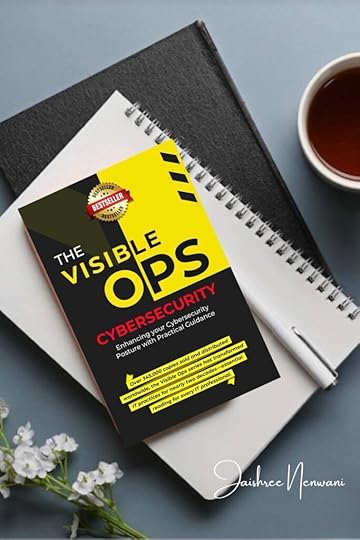
What really makes this book unique is its focus on balance. It doesn’t just dive into advanced tools like encryption, firewalls, or threat detection. Instead, it emphasizes the equal importance of people, processes, and technology working in tandem. Human error is one of the primary causes of security breaches, and the book repeatedly emphasizes the importance of a cybersecurity culture where every employee becomes an integral part of the defense system.
The addition of case studies from industries like healthcare, finance, and manufacturing makes it even more practical. These real-world stories show how the framework has been applied successfully, proving it’s not theory—it’s tested guidance you can start using today.
Core Lessons and Key TakeawaysSeveral concepts stood out for me:
Zero Trust Security Model – The principle of “never trust, always verify” is explained in depth. The book demonstrates how Zero Trust architecture can stop attackers from moving freely within a network by verifying every access request. Integrity Management – Ensuring that systems and data remain accurate and secure isn’t just about compliance; it’s about maintaining trust. Strong encryption, continuous monitoring, and access control are presented as non-negotiable practices. IT Process Alignment – By embedding cybersecurity into daily IT operations like configuration, change management, and release management, organizations strengthen both efficiency and resilience.The message is clear: cybersecurity isn’t a project with an end date—it’s a continuous improvement cycle.
Why Businesses Should Read This Book?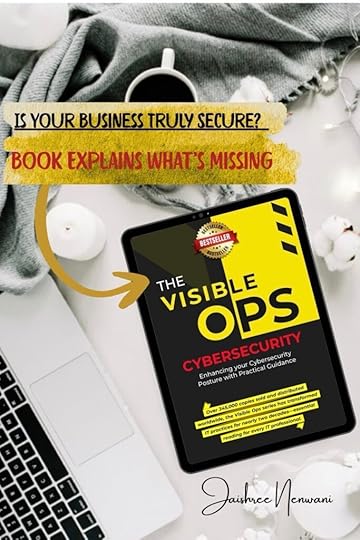
In today’s world, cyberattacks are not a matter of “if” but “when.” The book urges leaders to adopt an assume-breach mindset, where systems are built not only to prevent but also to withstand and recover from inevitable threats.
What I found refreshing is that the tone is never alarmist. Instead, it pushes organizations to focus on resilience, adaptability, and accountability. It makes the case that cybersecurity isn’t the responsibility of just IT—it’s a shared duty across the business.
Final ThoughtsReading Visible Ops Cyber Security reminded me that the strongest defenses don’t come from tools alone. They come from a well-aligned system of skilled people, repeatable processes, and smart technology choices. Whether you’re leading a small business or managing enterprise-level IT operations, this book provides a roadmap for creating a resilient cybersecurity posture that evolves as threats evolve.
About the AuthorScott Alldridge, CEO of IP Services and co-founder of the IT Process Institute, is a distinguished technologist with over 30 years of experience in IT and cybersecurity. A pioneer in ITIL-based best practices and a Certified Chief Information Security Officer (CCISO), Scott has authored multiple handbooks and spoken at major industry forums. His Visible Ops series has guided organizations worldwide in creating secure, efficient, and resilient IT operations.
The post Book Review: The Visible Ops Cyber Security – Building Resilient IT Operations with Zero Trust & Best Practices appeared first on Jaishree Nenwani.
August 18, 2025
5 Uncommon Self-Care Rituals That Take Less Than 10 Minutes (and Actually Change Things)
Many of us don’t have time for 90-minute rituals involving moon water, a crystal grid, and sit still to meditate or journal.
We’re women in motion—balancing work, relationships, maybe caregiving, definitely expectations—and we don’t get enough time to do more in the name of self-care. What we need are tiny, sacred rebellions. Rituals that take a minute, not a morning. Shifts that feel like “just me” again, not another item on the to-do list.
So, here are five of my favorite UNCOMMON self-care rituals. They take under 10 minutes, and yes—they shift everything. You don’t need a yoga mat. You don’t need a therapist on speed dial (though bless them). All you need is just you, your attention, and a dash of intention.
1. The Radical Pause (60 seconds of doing absolutely nothing)
Here’s how this goes:
Put your hand on your heart.
Close your eyes.
And… do nothing.
Not meditating. Not visualizing. And not trying to “manifest” anything.
Just being.
Radical, right?
In a world that praises productivity like it’s a religion, doing nothing—even for 60 seconds—is straight-up rebellion. It’s sacred stillness. It’s you saying, “I exist outside of output.”
Set a timer if you must. But don’t fill this time. Just sit. Exist. Be deliciously unproductive for one whole minute.
2. The Morning Anchoring Mug (because coffee counts)Choose your morning drink. Tea. Matcha. Lemon water. Or coffee, obviously.
Now drink it like a ritual, not a race.
No emails. No scrolling.No mentally prepping your to-do list.Just you, your warm mug, and the quiet hum of being human before the day steals you away.
I call this my “sip-and-sink” moment. I sip, and I sink into myself. Even if it’s just 3 minutes, I’m anchored. And on tough mornings, it’s the one thing that says, “I got you, girl.”
3. The “No List” (because boundaries are self-care)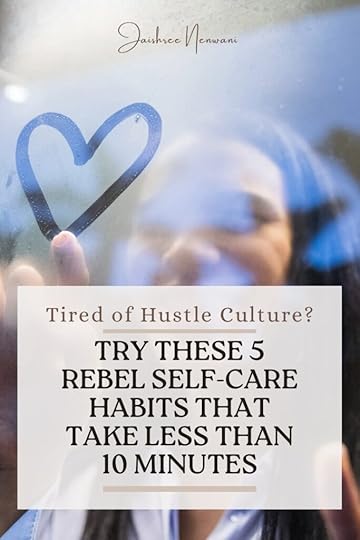
We’ve been tricked into thinking self-care is about adding more stuff: more habits, more journaling, more green smoothies.
But sometimes the boldest self-care is subtraction.
So every Monday, I write a quick “No List.” Three things I’m not doing this week.
Example:
Not replying to every WhatsApp groupNot signing up for that online course I secretly don’t care aboutNot saying yes when my soul’s saying “ugh no”This is your permission slip to opt out. You don’t need to hustle for worthiness. You don’t need to RSVP yes to everything. Cross it off before it crosses you out.
4. The Bedtime Brag List (because we forget how amazing we are)Every night, I scribble down three tiny wins from the day. I call it my Bedtime Brag List.
Asked for what I neededDidn’t doom-scroll at lunchReheated leftovers instead of skipping dinnerSaid no to something that I didn’t want to doNo, these aren’t Insta-worthy. But they are nervous-system rewiring worthy.
Because when your brain gets in the habit of noticing wins, it stops obsessing over what’s missing.
Bragging isn’t bad. It’s brain training.
Celebrate yourself—especially when no one else is clapping.

When life feels loud and everything’s just… too much, I reset through one sense at a time.
No big ceremony, no chanting required.
Examples:
Inhale clary sage or orange essential oil
Play one calming song (James Blake, anyone?)
Wrap yourself in something cozy
Step outside, touch a leaf, breathe like the trees do
Your senses are literal portals back to calm. Pick one and reset in under 3 minutes.
Because sometimes the best therapy is stepping outside and whispering “wtf” to a plant.
Wrapping Up on Uncommon Self-Care RitualsThe entire month might blur past in a mess of deadlines, dishes, social noise, and inner chaos. But please don’t let it blur you out of the picture.
Although I am a big fan of having a good morning routine in place, but it is not always possible to take out an hour or two to take care of yourself in the midst of chaotic runarounds. So, instead of feeling guilty about not being able to set up a good routine, try spending 10 powerful minutes on yourself.
You are not just the doer, the giver, the glue.
You’re a whole woman. With desires. Needs. A nervous system. A soul.
You’re allowed to rest without earning it.
You’re allowed to unplug without apology.
And you’re also allowed to take up space without explaining yourself.
These rituals aren’t magic. But they are medicine. They remind you that self-care isn’t a luxury. It’s your baseline.
So if no one told you today:
You’re doing so much better than you think.
And you, dear woman, deserve to feel like you again.
P.S. Want more rebel rituals?
Stick around. This space is for women who are done performing wellness and ready to live it—softly, boldly, on their own terms.
The post 5 Uncommon Self-Care Rituals That Take Less Than 10 Minutes (and Actually Change Things) appeared first on Jaishree Nenwani.
August 14, 2025
Guided Greatness by Dr. Kevin D. Neal – A Powerful Leadership & Mentorship Guide
Some books teach leadership. Guided Greatness teaches legacy.
From the very first chapter, it’s clear this isn’t just another “how to lead” manual—it’s a heartfelt blueprint for raising future leaders who can carry the torch long after you’re gone.
Dr. Kevin D. Neal writes not from theory alone but from over forty years of living and leading in faith-based, corporate, military, and public service environments. You can feel the depth of his experience in every chapter. He’s seen leadership at its best and worst, and he’s not afraid to call out the gaps—especially when it comes to mentoring and preparing the next generation of leaders.
What Sets This Book Apart?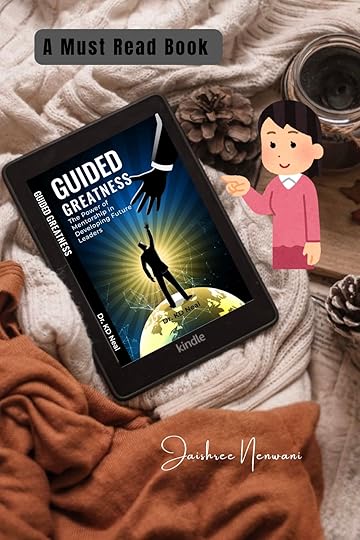
What struck me most is his clear message: leadership is temporary, but legacy is forever. The way you mentor determines what happens after you’re gone. This isn’t just about filling positions—it’s about shaping people, passing on wisdom, and ensuring stability for the future.
I loved how Dr. Neal weaves in lessons from Jesus and the Apostle Paul as mentors. These aren’t just Sunday School references—they’re practical case studies in leadership succession. He also shares personal stories, like learning music without formal training, to show why mentorship matters so much: without guidance, potential often stays unrealized.
My ThoughtsIf leadership is about influence, mentorship is about multiplying it.
It’s the difference between making an impact for a season and leaving a legacy that lasts.
The book doesn’t just preach—it gives structure. From identifying future leaders to building genuine mentor-mentee relationships, to overcoming insecurities that make senior leaders hold back, it’s all here. And the tone is refreshingly honest. He talks about vulnerability, trust, and even the fears that stop leaders from mentoring in the first place.
If you lead a business, church, or any organization—and especially if you care about what happens after you leave—Guided Greatness is a must-read. It’s part leadership manual, part personal challenge, and part heartfelt reminder that real leaders don’t just build teams; they build people. Grab your copy on Amazon.
About the AuthorDr. Kevin D. Neal, DMin, is a seasoned leader with over four decades of experience spanning faith-based, corporate, military, and public safety sectors. Known for his deep commitment to developing future leaders, he blends biblical principles with practical leadership strategies. Through Guided Greatness, he shares his passion for mentorship, succession planning, and building organizations that thrive for generations to come.
Enjoyed reading about this book? Head towards the Book Review section to discover more books worth reading.
The post Guided Greatness by Dr. Kevin D. Neal – A Powerful Leadership & Mentorship Guide appeared first on Jaishree Nenwani.
August 7, 2025
Never Stay Broke by Joseph Rutakangwa – A Life-Saving Guide for Anyone Starting From Zero
When you’re staring at an empty wallet, overdue bills, and mounting pressure, the last thing you need is fluffy advice or get-rich-quick slogans. You need something real. That’s where Never Stay Broke by Joseph Rutakangwa steps in—a raw, honest, and highly-practical guide for anyone trying to survive financial hardship or rebuild from ground zero. Whether you’re jobless, overwhelmed, or simply stuck, this book hands you something priceless: a roadmap you can actually follow—starting today.
A Manual for Survival (Not Just Money Advice)The book is broken down into three clear parts: Survival, Stability, and Legacy. Each phase offers practical advice tailored to your current stage, whether you’re just trying to eat today or building a future that includes financial freedom.
In the Survival section, you’ll learn how to make cash in the next 24 hours using what you already have—no degree, no business, no perfect credit required. You’ll find gritty ideas like flipping free items, offering micro services, or using gig apps to generate income right away.The Stability phase moves you from daily panic to monthly planning—helping you build routines and rhythms that offer breathing space and structure.
The Legacy section is all about long-term impact—creating a life where you’re not just surviving but passing on strength, stability, and freedom.
What Sets This Book Apart?
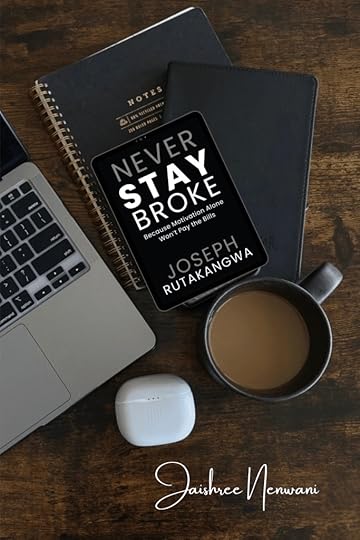
It’s brutally honest. Rutakangwa doesn’t pretend success is easy or instant. He acknowledges the shame, fear, and paralysis that often come with being broke. He speaks directly to the reader who’s exhausted, discouraged, and overlooked. There’s no toxic positivity here—just clarity, compassion, and courage.
He teaches that action—even the tiniest step—matters more than motivation. Whether it’s selling an old jacket, offering to babysit, or borrowing a tool to flip a $0 find, this book insists on one truth: your power is in your motion. Not your background, not your bank account, not your perfect plan. Just your willingness to try, again and again.
Why You Should Read It (Even If You’re Not Broke)Never Stay Broke isn’t only for people in deep crisis. It’s also a wake-up call for anyone feeling stuck, financially fragile, or quietly desperate for change. It gives readers not just ideas, but permission to begin from wherever they are. If you’ve ever needed proof that you can rebuild from scratch, this is that proof.
Whether you’re jobless, rebuilding after a loss, or simply sick of feeling like you’re always behind—this book will hand you your first win. And then your next. This outstanding book is all set to release on Amazon on 9th September 2025, you can preorder it and book your copy.
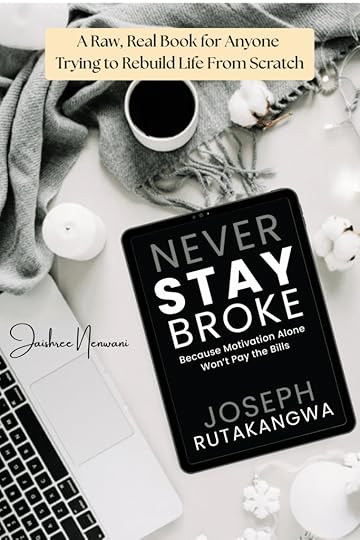 About the Author
About the AuthorJoseph Rutakangwa is a Tanzanian-born entrepreneur, writer, and resilience-builder. He writes from lived experience—having watched his family rise, fall, and start again from rock bottom. His work blends street-smart wisdom with deep empathy, and Never Stay Broke is a testament to his core belief: even when you have nothing, you still have the power to act.
Enjoyed reading about this book? Head towards the Book Review section to discover more books worth reading.
The post Never Stay Broke by Joseph Rutakangwa – A Life-Saving Guide for Anyone Starting From Zero appeared first on Jaishree Nenwani.
July 21, 2025
The Small Business CEO’s Playbook – Must-Read for Entrepreneurs
As someone who’s been both excited and overwhelmed by the idea of running a small business, The Small Business CEO’s Playbook by Rob Peters DiFazio felt like the grounded, real-talk guide I didn’t know I needed.
What is The Small Business CEO’s Playbook All About?What I loved most about this book is how approachable it is. Rob doesn’t talk down to you or fill the pages with complex jargon. Instead, he writes like a mentor who’s been in the trenches—because he truly has. With over 35 years in the entertainment industry, Rob shares lessons he learned the hard way, making this book feel less like a textbook and more like a conversation over coffee with a trusted coach.
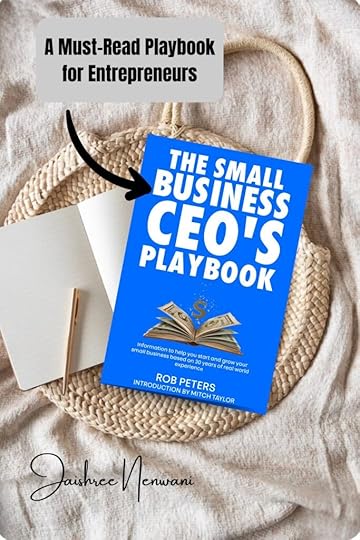
Right from the first chapter, he dives into his journey—starting out as a mobile DJ in the late ’80s, learning business lessons from his father, and later adapting his company to major shifts like the COVID-19 pandemic. His honesty about both successes and setbacks makes the book relatable and real.
One of the standout parts of the book for me was his emphasis on taking action. Rob reminds us that ideas only work when we actually implement them. He pushes readers to stop overthinking and start doing—setting goals, tracking progress, and learning from failures (yes, he even says failure can be a good thing!). That message really stuck with me.
Another section I found incredibly helpful was about building a business plan and a strategic plan. Rob breaks down the differences, explains why both matter, and walks you through how to create each one. And he doesn’t just tell you what to do—he offers examples, outlines, and simple steps to make it doable even if you’re just starting out.
My Thoughts About The Small Business CEO’s Playbook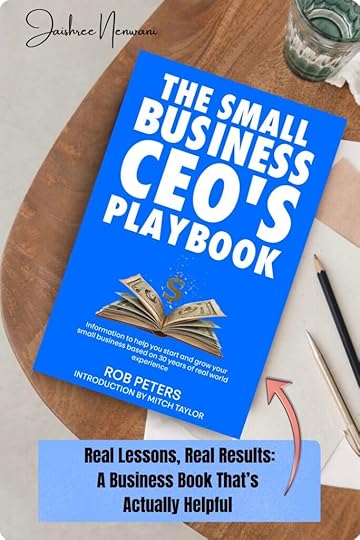
His 10 rules for business success, including tips like “Don’t do stupid stuff” and “Always keep learning,” are simple but powerful. They’re the kind of reminders that don’t just apply to business, but to life in general. Rob also shares great insights about professionalism, setting client expectations, and building strong relationships—even with competitors.
What sets this book apart is how practical it is. Rob’s advice is based on real-world experience, not theory. He’s made the mistakes, learned the lessons, and now he’s sharing them so we don’t have to repeat them. Whether you’re launching a side hustle or running a full-time small business, this playbook offers clarity, direction, and encouragement.
If you want a straight-talking guide to help you think like a CEO—even if you’re a team of one—this book belongs on your shelf. You can get this book on Rob’s website. It’s a toolbox full of strategies, mindset shifts, and motivation for anyone who’s serious about growing a small business.
About the AuthorRob Peters DiFazio has been running businesses for over 35 years. He started out as a mobile DJ in 1987 and turned that side hustle into a full-time career. Today, he runs Rob Peters Entertainment, a company known for fun events like trivia nights, game shows, and kids’ entertainment—especially in daycares.
Over the years, Rob has learned how to adapt to big changes, including tough times like the COVID-19 pandemic. He now helps other small business owners through his books, coaching, and podcast. Rob loves sharing what he’s learned so others can grow their own businesses with more confidence and fewer mistakes. He’s also a popular speaker and trainer, always ready to support fellow entrepreneurs on their journey.
Check out more informative books on Entrepreneurship.
The post The Small Business CEO’s Playbook – Must-Read for Entrepreneurs appeared first on Jaishree Nenwani.
July 16, 2025
Dear Rookie, Don’t Panic by Pawan Kumar Marella – Honest Career Advice for the Modern Workplace
They say corporate life doesn’t come with a manual—but what if it did? Dear Rookie, Don’t Panic by Pawan Kumar Marella feels exactly like that: a warm, witty, no-nonsense manual for anyone stepping into (or stumbling through) the working world. This isn’t one of those preachy leadership books filled with clichés and complex models. Instead, the author offers hard-earned wisdom, relatable stories, and practical tools—all served with a dose of humour and a very human voice.
What is Dear Rookie, Don’t Panic all About?From the first few pages, I felt like I was sitting across from a wise (and very real) mentor who’s not afraid to laugh at his own mistakes. The book is divided into three powerful sections—You Versus You, You and Others, and The Future You—each packed with insights, personal anecdotes, and refreshing honesty.
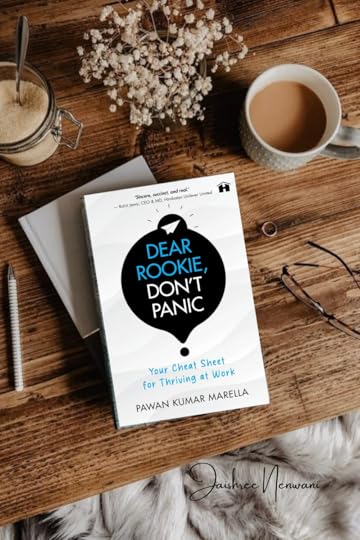
The first section, You Versus You, dives into the internal struggles most of us face when we start our careers: self-doubt, stress, the pressure to “prove ourselves,” and more. Pawan’s story about literally forgetting how to breathe due to stress hit home for me. He reminds us that health, integrity, trust, and the habit of showing up are non-negotiables, not just nice-to-haves. This part made me pause, take a breath, and reflect on how I show up for myself every day.
In You and Others, he zooms out to talk about working with people, building trust, and navigating office culture. One line stuck with me: “The one person you didn’t say hello to in your first 100 days is the same person holding up your work today.” It’s true. The small things—greetings, honest conversations, asking “How can I help?”—can ripple into big results. His tips on building relationships, seeking feedback, and knowing when to speak up are gold for anyone who wants to be seen as reliable and respected, not just efficient.
The Future You is all about leadership and growth. It’s not sugar-coated. Pawan talks about promotions that didn’t come, product launches that flopped, and tough lessons that took years to sink in. But that’s what makes it real. His advice on crafting your personal brand, leading with authenticity, and making peace with imperfect situations made me feel seen.
My Thoughts on Dear Rookie, Don’t Panic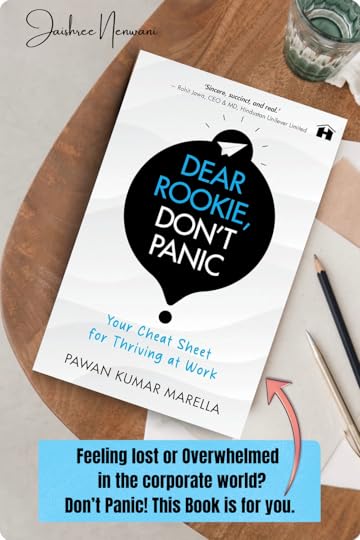
What I love most about this book is its tone—it’s smart without being arrogant, thoughtful without being boring, and relatable without dumbing anything down. One of the best takeaways for me was to start writing your appraisal on day one—not for your boss, but for you. It’s such a clever way to stay focused on what actually matters. Whether you’re just starting out, switching careers, or secretly wondering if you’re still a rookie (like I sometimes do), this book has something for you. Grab Your Copy on Amazon.
About the AuthorPawan Kumar Marella is a global business leader with over 20 years of experience across countries and cultures. From India to Ethiopia to Nairobi and beyond, his career journey is filled with learnings, stumbles, and standout moments—all of which fuel the pages of this book. Pawan believes in leading with clarity, courage, and compassion. Dear Rookie, Don’t Panic is his way of sharing what no one tells you about life at work—until it’s too late.
Enjoyed reading about this book? Head towards the Book Review section to discover more books worth reading.
The post Dear Rookie, Don’t Panic by Pawan Kumar Marella – Honest Career Advice for the Modern Workplace appeared first on Jaishree Nenwani.
June 25, 2025
A Simple Monthly Ritual That Changed My Life
Life moves fast. Too fast, sometimes. Between deadlines, responsibilities, and the constant buzz of notifications, it’s easy to get caught up in the daily grind without ever stepping back to ask: Am I even heading in the right direction?
A few months ago, I realized I was running on autopilot. I was busy, sure, but was I productive? Was I growing? Was I making choices that truly mattered to me? The truth was, I wasn’t sure.
That’s when I decided to introduce something new into my life—something I now call Press Pause Day.
What is Press Pause Day?
It’s one day a month where I step away from my routine, disconnect from distractions, and just think. No meetings, no to-do lists, no emails, no social media. Just me, my thoughts, and the space to reflect on where I’m going.
It’s not a day for errands or catching up on tasks. It’s a day for big-picture thinking. A reset button. A chance to check in with myself and make sure I’m not just moving, but moving in the right direction.
Why I Needed This Ritual?Before starting this, I often felt like I was chasing an endless list of tasks but never pausing to ask if those tasks even mattered. I’d set goals in January and forget about them by March. I’d make plans, but life would get in the way. And I’d start projects, only to realize months later that they weren’t taking me where I wanted to go.
I needed a system to stop and recalibrate—to make sure I was living intentionally, not just reacting to whatever came my way.
How I Do It?I keep it simple. No rigid rules, no pressure to make it perfect. Just a few guiding principles that help me make the most of this day.
1. Pick a Day and Protect ItI choose one day every month in advance and mark it on my calendar. Once it’s scheduled, I treat it like an unmissable appointment. No rescheduling. No excuses.
2. Disconnect from the NoiseOn this day, I take a break from emails, social media, and work messages. The goal is to step away from the constant input and create space for deeper thinking.
3. Change My Environment
Staying at home doesn’t work for me—I get too tempted to do some home chores or check my phone. So, I go somewhere different. A quiet café, a park, or even a hotel lobby. The change in scenery helps shift the mindset.
4. Use a Few Powerful QuestionsI don’t force myself to follow a strict structure, but I do have a few questions that guide my reflection:
Am I spending my time on what truly matters? What’s working well in my life, and what isn’t?Where do I want to be a year from now, and am I on track?What’s holding me back, and how can I change that?What is one thing I can do this month to move closer to my goals?I write my answers in a notebook—nothing fancy, just honest thoughts. It’s amazing how much clarity this simple exercise brings.
5. Let My Mind WanderSome of the best ideas come when I’m not actively trying to solve a problem. So, I allow space for free thinking. Sometimes, I take a long walk. Other times, I just sit with a cup of tea and let my thoughts flow.
6. End with a Simple PlanBy the end of the day, I jot down a few key takeaways and one or two small actions to focus on for the next month. Not a long to-do list—just meaningful steps that align with where I want to go.
What This Ritual Has Done for Me?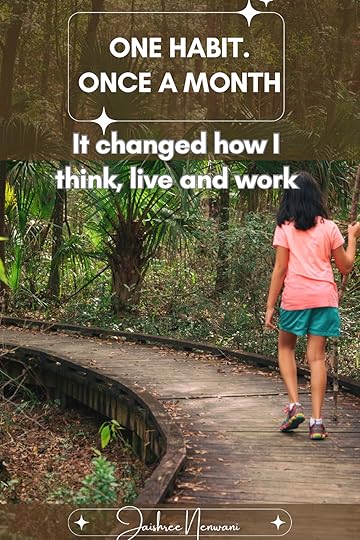
Since starting this, I feel more in control of my life. I no longer feel like I’m just reacting to everything around me. I have more clarity on what truly matters, and I make better decisions because of it.
I’ve noticed that the more consistent I am with this ritual, the more aligned my daily actions become with my bigger goals. And the best part? It doesn’t take much—just one day a month.
What If You Tried It?If you’ve ever felt stuck, overwhelmed, or unsure about where you’re headed, I encourage you to try this. Start with just one day. No pressure, no perfection—just a simple pause to think, reflect, and realign.
Who knows? It might just change your life too.
The post A Simple Monthly Ritual That Changed My Life appeared first on Jaishree Nenwani.
May 30, 2025
Dynasties of Devotion by Deepa Mandlik: An Intimate Exploration of Sacred Temples
The moment I began reading Dynasties of Devotion by Deepa Mandlik, I realized this was no ordinary travelogue. It wasn’t just about exploring seven temples, but about stepping into a rich tapestry of history, spirituality, and personal reflection. This book isn’t merely about grand structures; it’s about the living, breathing heart of these temples, the people who built them, and the generations that have kept their stories alive.
What Makes This Book Unique?Temples in India aren’t just stone and sculpture. They are, as Mandlik so eloquently reveals, living, breathing centers of devotion, identity, and continuity. Her narrative meanders through time, taking us from the grandeur of the Kailasa Temple in Ellora to the majestic Angkor Wat in Cambodia, weaving stories of dynasties, art, and devotion along the way. What makes this book stand apart is her approach—it’s not the detached observation of a historian or the quick notes of a tourist. Mandlik’s voice is that of a curious traveler, filled with wonder, reverence, and an eye for the details most of us would overlook.
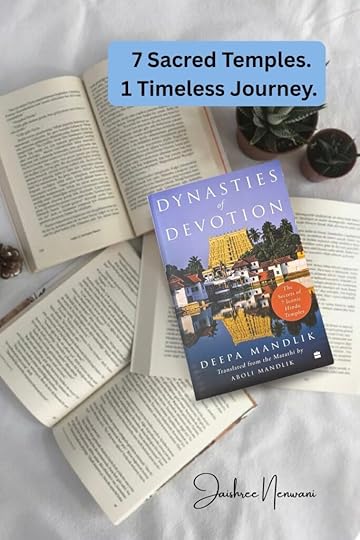
Accompanied by her husband and with her daughter, Aboli Mandlik, translating from the original Marathi (Parakrami Hindu Rajanchi Adwitiya Mandire), the author brings an intimate tone to what could easily have been a dry academic study. This is not just a book to read—it’s one to experience. The descriptions are vivid, the observations thoughtful, and the attention to the smallest details—be it a sculpture, a motif, or the energy within a temple—breathtaking. At times, I found myself pausing to absorb the sheer magnitude of these structures and the untold stories of the artisans who created them.
What Made Me Stick to This Book?What struck me deeply was how Mandlik highlighted the temples as more than architectural marvels. They were—and still are—energy centers, places where cosmic intent meets human devotion. Her explanations of how temples were designed to harness natural elements, how mantras and rituals generate specific energies, and how even the placement of trees like neem, peepal, and tulsi serve a higher purpose, were both fascinating and humbling. It made me look at temples with fresh eyes—not as static relics of the past but as dynamic spaces of spiritual, environmental, and cultural significance.
The book isn’t just a collection of temple tales. It’s also a gentle critique of modern myths, like the viral social media claims suggesting alien origins for the Kailasa Temple. Mandlik dismantles such theories with grounded research and reverence for the human ingenuity that built these wonders. Her meticulous exploration of dynasties, their socio-political contexts, and the sheer effort behind each temple’s creation brings to life a rich tapestry of history that left me in awe.
My Thoughts About Dynasties of Devotion by Deepa Mandlik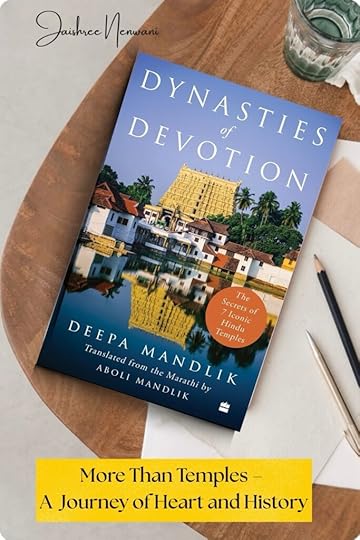
While I appreciated her detailed descriptions, I did find myself needing to pause and reflect often. The prose, though poetic, can get dense, and at times I wished for more photographs to accompany the narrative. But perhaps that’s the beauty of the author’s work—she challenges readers to slow down, to savour each story, each stone, each sacred chant, and each layer of history that these temples represent.
If you’re a lover of history, architecture, spirituality, or just someone who appreciates a well-told story, Dynasties of Devotion is a book that will resonate. It’s not a guidebook—it’s an invitation to embark on a journey, to see these temples not just as buildings but as living, breathing testaments to human faith and creativity.
I closed the book with a sense of gratitude—for Mandlik’s dedication, for the artisans and devotees who kept these temples alive, and for the cosmic dance that continues within their walls.
About the AuthorDeepa Mandlik is a distinguished Marathi writer and researcher, known for her passionate explorations of Indian heritage and spirituality. Her original work, Parakrami Hindu Rajanchi Adwitiya Mandire, received prestigious accolades including the ‘Best Reference Book of the Year Award’ by Akhil Bhartiya Marathi Prakashak Sangh and the ‘Best Book of the Year Award’ by Granthottejak Sanstha, Pune. Accompanied by her husband and supported by her daughter’s translation, Mandlik brings a deeply personal lens to her work, offering readers a unique blend of historical rigor and heartfelt storytelling.
Wanna discover more interesting books? Head towards the Book Review section.
This review is powered by Blogchatter Book Review Program.
The post Dynasties of Devotion by Deepa Mandlik: An Intimate Exploration of Sacred Temples appeared first on Jaishree Nenwani.



